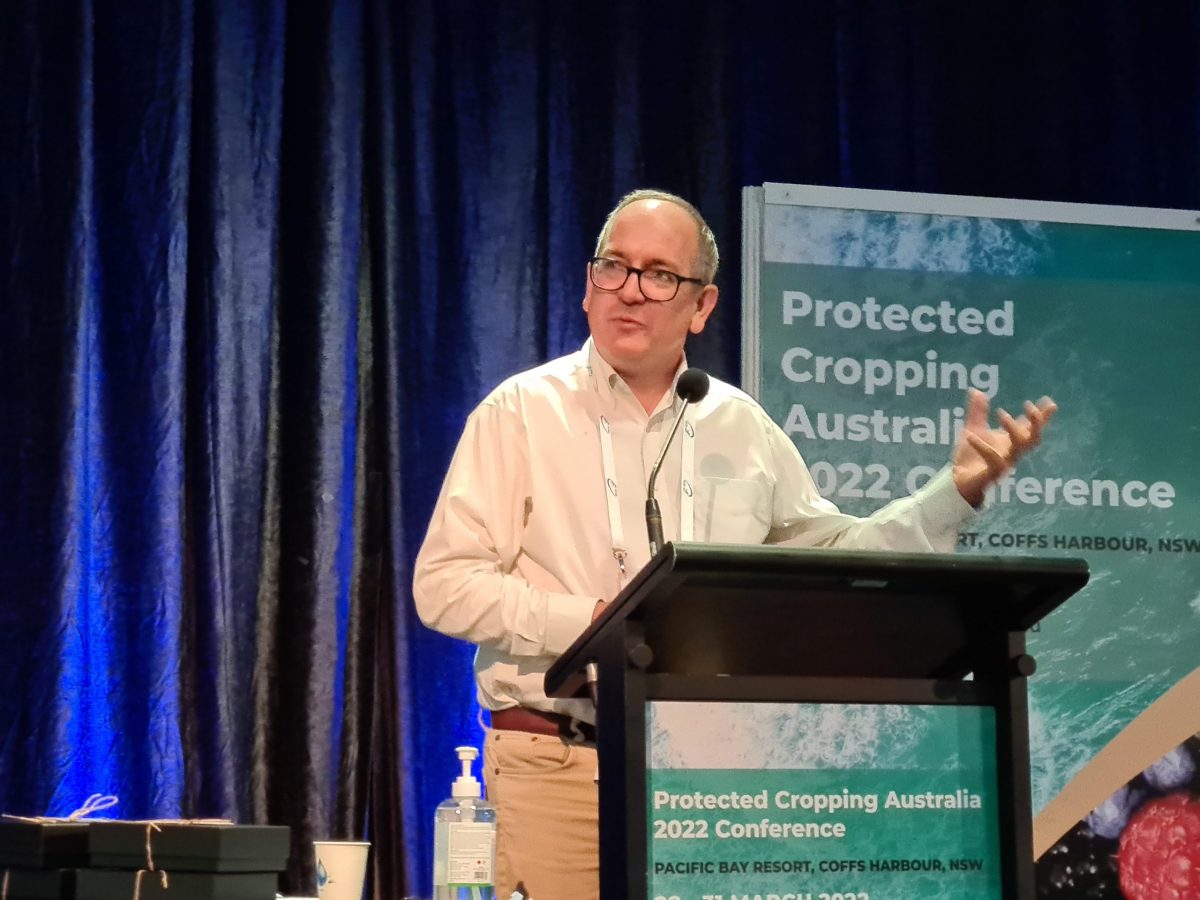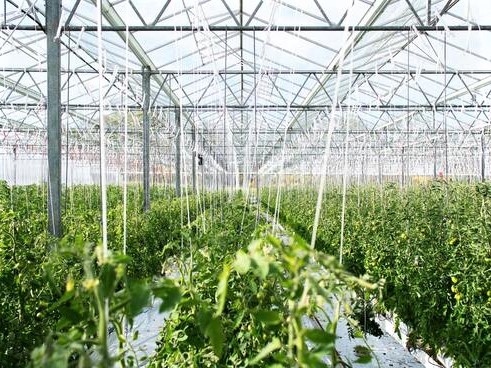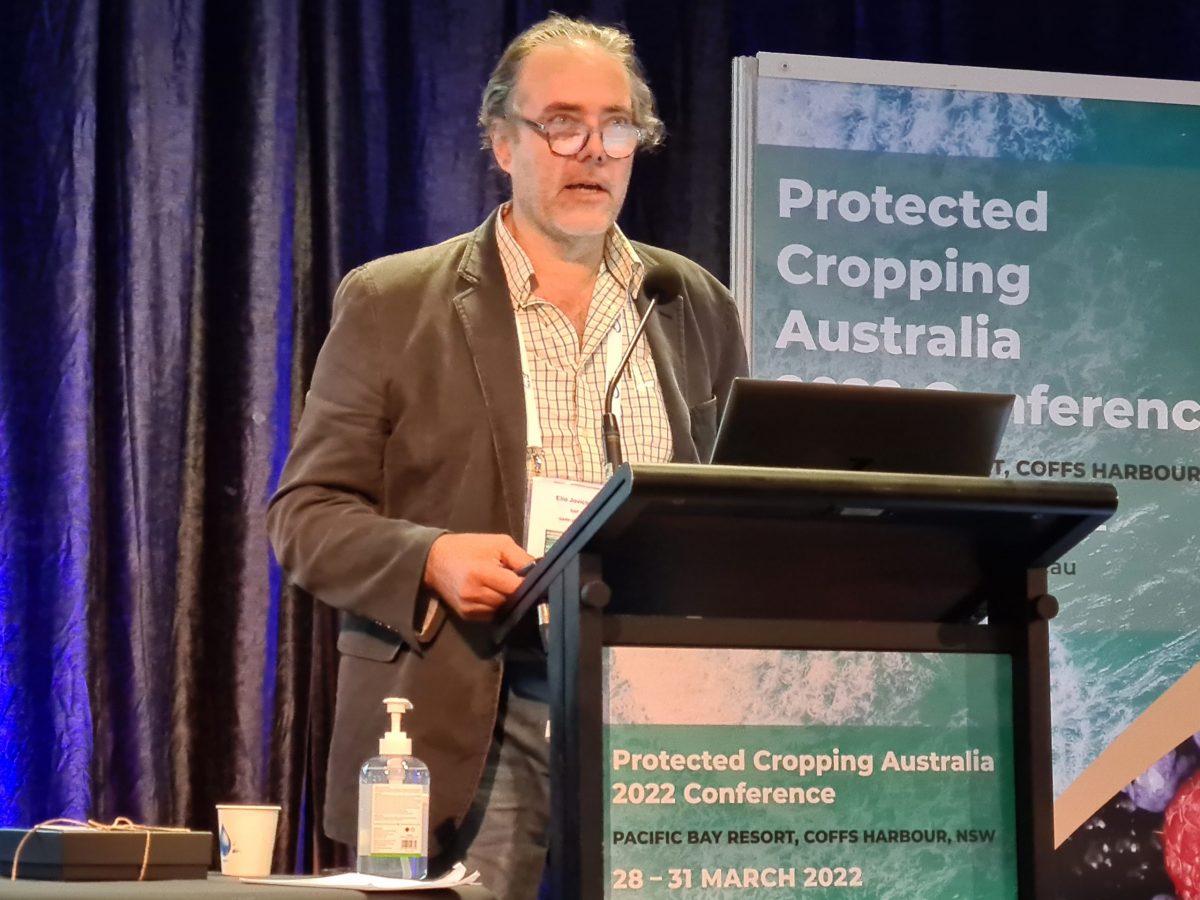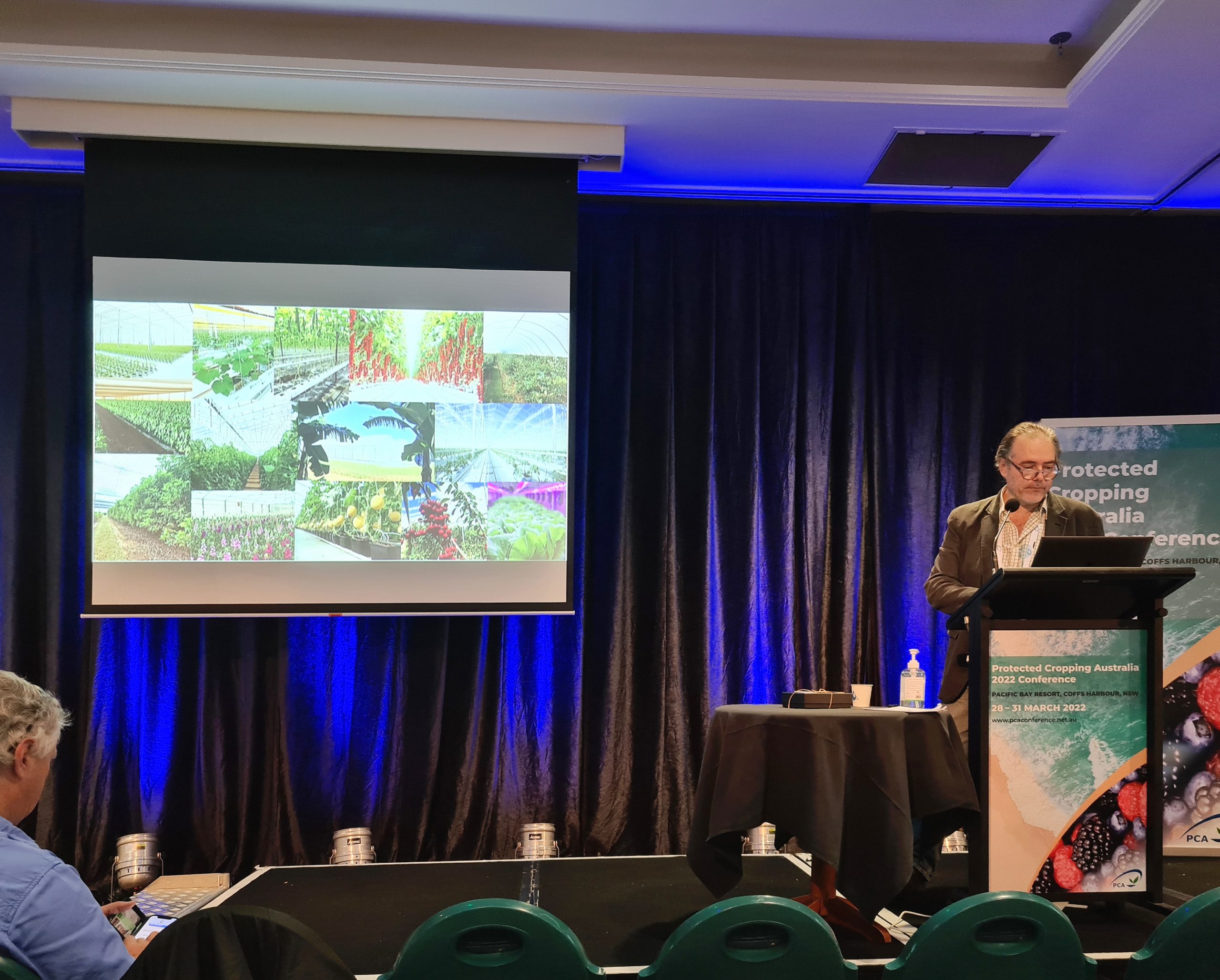A new strategy developed by the Queensland Department of Agriculture and Fisheries and Strategic Journeys with input from around 150 industry stakeholders, including the Future Food Systems CRC, aims to provide direction and support for those growing crops under shelter across Australia.
At the official launch event in late November 2021, Minister for Agriculture and Northern Australia David Littleproud said the ‘Australian Protected Cropping Strategy 2021-2030’ provided a pathway for the industry.
“The strategy will look to increase knowledge and the capacity of industry to adopt and take advantage of protected cropping systems,” Minister Littleproud said. “With these systems we can look at developing new markets, both domestically and internationally.
“There is huge potential for protected cropping, and I’m really excited for what the next decade could bring.”

Hort Innovation Head of R&D Byron de Kock addressing delegates at the 2022 PCA Conference in Coffs Harbour. Credit: Merran White
Speaking at the Protected Cropping Australia (PCA) Conference 2022 at Coffs Harbour, Hort Innovation’s Head of Research & Development Byron de Kock told delegates that developing value chains for export, investing in a skilled workforce and harnessing automation and technology are key pillars of the Strategy.
“It’s important to develop profitable and diversified value chains, and identify opportunities to grow exports across protected cropping,” de Kock said. “The next is people: a key theme is to inspire the future generations to get involved in horticulture, and you can’t do that without investing in them. We want to develop a strong protected cropping workforce. Another is technology, and we want to focus on harnessing approaches to automation, robotics the use of key data.
“But why are we doing it? We really want to drive outcomes for growers.”
Horticulture is Australia’s third largest agriculture commodity, worth more than 15 billion dollars. In the past five years, the sector has grown by 27 per cent. Right now, Hort Innovation has more than $413 million invested in 348 research projects, including the Australian Protected Cropping Strategy 2021-2030.
“We spoke to 47 organisations and 100 individuals as we developed this strategy, and re-defined protected cropping, and perhaps expanded the definition,” de Kock told PCA Conference delegates. “We looked at the global mega-trends and, importantly, the strategy identifies potential deliverables and KPIs, so we can confirm priorities and make the right investments.”
Implementation of the Strategy is being led by Protected Cropping Australia with support from Hort Innovation.

A modern protected cropping facilities. Credit: LLEAF Pty Ltd
PC-based production tipped to grow
Hort Innovation Chief Executive Officer Matt Brand said protected cropping-based horticultural production is tipped to grow considerably.
“Because protected cropping provides control over growing conditions, a dedicated strategy is vital,” Mr Brand said.
“From high-tech glass houses to basic covers and nets, protected cropping is becoming a popular choice for Australian horticulture.
“With input from industry, this strategy provides an important roadmap to drive innovation and competitiveness in the horticulture sector.”
The strategy was developed by Elio Jovicich and Vicki Lane from the Queensland Department of Agriculture and Fisheries (DAF), and Gary Saliba from Strategic Journeys, with input from a wealth of industry stakeholders including the CRC.

Elio Jovicich says the new Protected Cropping Strategy offers stakeholders a clear direction and priorities for funding RD&E to benefit vegetable, berry, nursery and horticulture tree-crop value chains. Credit: Merran White
Extensive consultation
Dr Jovicich, Program Leader Protected Cropping, said the Australian Protected Cropping Strategy provides horticulture growers, businesses and industry stakeholders with a clear direction and priorities for investment in research, development and extension (RD&E) to benefit vegetable, berry, nursery and tree-fruit value chains.
“The strategy is based on extensive consultation with industry stakeholders, as well as an analysis of global trends in the use of protected cropping within horticulture,” Dr Jovicich said.
“Almost 50 organisations and more than 100 individuals were engaged as part of its development, including State and Territory agricultural departments, industry associations, universities and educational centres, growers, marketing groups, consultants, and suppliers.
“The consultation highlighted several challenges to the future growth of the sector, as well as opportunities to harness protected cropping and industry growth.
“The information was used to identify protected cropping RD&E outcomes and strategies, which were road-tested and refined with industry stakeholders and Hort Innovation.

The Protected Cropping Strategy at a glance: a slide from Jovicich’s presentation at the 2022 PCA Conference. Credit: Merran White
Value chains, people and technologies
“Three pillars aligning with Value Chains, People, and Technologies were identified and have specific investment priorities,” Dr Jovicich said.
“For an expansion of protected cropping in Australia we need to develop and access export markets while growing new domestic markets, increase workforce capacity and capability, and adapt and develop fit-for-purpose, cost-effective protected cropping technologies and agronomy practices.
“The industry will also need to assure that the environmental footprint is well managed.
“A systems approach to RD&E will be required to solve the challenges, and collaboration across industry players will be fundamental,” Dr Jovivich said.
Protected Cropping Australia’s Chief Executive Officer at the time, Greg Fraser, said the Strategy will prove a useful tool for industry.
“Australia’s horticulture industry has a great capacity and capability to harness the potential of protected cropping systems across a diversity of crops, regions, climates, business models and markets,” he said.
“This Strategy outlines opportunities for research, development and extension in the context of global megatrends, local challenges and opportunities and other factors.”
The ‘Australian Protected Cropping Strategy 2021-2030’ was funded through Hort Innovation’s Hort Frontiers Advanced Production Systems Fund, the Australian Government and the Queensland Department of Agriculture and Fisheries with input from Food Innovation Australia Ltd (FIAL).
Access the ‘Australian Protected Cropping Strategy 2021-2030’ here.
This article was first published on the Hort Innovation website on 26 November 2021. It has been republished here with minor editorial modifications courtesy of the Hort Innovation media team. View the original article.
Lead image: Elio Jovicich presents the Australian Protected Cropping Strategy 2021-2030 to delegates at the PCA Conference in March. Credit: Merran White


